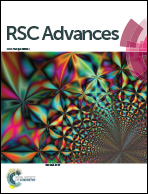Cuprous oxide template synthesis of hollow-cubic Cu2O@PdxRuy nanoparticles for ethanol electrooxidation in alkaline media
Abstract
Surfactant-free and low Pd loading Cu2O@PdxRuy hollow-cubes were facilely prepared via a galvanic replacement reaction with electrodeposited Cu2O cubes as sacrificed templates. The morphology and composition of the as-synthesized nanoparticles were characterized, through which the Pd : Ru atomic ratio, metal loading, surface composition and structure of several Cu2O@PdxRuy nanoparticles were determined. The promotional role of Ru on electrooxidation of ethanol in alkaline media over Cu2O@PdxRuy was investigated. By comparison, the following electrocatalytic activity order of the catalysts was obtained: Pd/C < Cu2O@Pd < Cu2O@Pd1Ru3 < Cu2O@Pd3.5Ru1 < Cu2O@Pd2.1Ru1 < Cu2O@Pd1Ru1.6 < Cu2O@Pd1Ru1. Combined with the stability study, the hollow-cubic Cu2O@Pd1Ru1 nanoparticles show superior catalytic activity and stability toward electrooxidation of ethanol in alkaline media compared to the other catalysts studied in this work which is attributed to the appropriate Pd : Ru ratio and the hollow-cubic structure.


 Please wait while we load your content...
Please wait while we load your content...